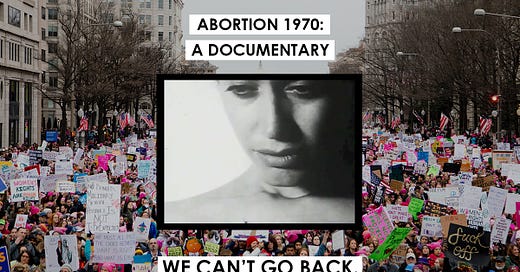Three feminists draw attention to landmark abortion rights film
1970 movie shows what women went through prior to Roe v. Wade when they wanted to deal with an unwanted pregnancy
Three women behind an important feminist film released in the 1970s want to draw attention to it after the Supreme Court overturned Roe v. Wade.
Abortion and Women’s Rights was released in 1970. It tells the stories of two women’s illegal abortions. The film was ahead of its time in that it called for intersectional demands, including an acknowledgment of the troubling treatment of Black and Puerto Rican women, including forced sterilization. I sat down with three of the documentarians—Jane Pincus, Karen Weinstein and Mary Summers—to talk about that film and what’s going on now in feminism.
At the time, Weinstein had been part of an activist film group called Newsreel. There were hardly any movies or material being made by women for women then.
“That's part of why I started looking around to see what we could do because women’s voices were not being heard, at least not in films,” Weinstein said.
Pincus said that the most powerful way to teach women’s history is to have first-hand accounts of people telling it. The fact that they were part of it makes it seem and feel more urgent.
Karen Weinstein thinks that understanding history will be vital to fighting for women’s empowerment.
“There's always a minimizing of women's history,” she said. “I think there’s more of a reawakening now that the history of the fight for abortion is important. I'm hoping that we move more in the direction of learning from history.”
Weinstein said it’s still difficult for abortion to be discussed freely and without stigma. “We need to create opportunities for women to speak out safely about their experiences,” Weinstein said.
“It's a challenge to make sure that these issues are spoken about in a public way, and a way that everybody can understand,” Weinstein said. “It's not the easiest thing to talk about.”
It’s always interesting seeing how different feminist generations presented themselves. And in that way, the film is instructive on how the second wave approached advocacy and activism as compared to today. Mary Summers contrasted the youth of that era with that of this one. She said the biggest difference that worries her is today’s reproductive generations don’t talk to people they disagree with nearly as much as the boomers did.
“Obviously some people back then focused mainly on developing their own positions and rhetoric. But I do think there was a tremendous effort to do a lot of outreach and organizing.”
For the past year or so, several journalists have penned pieces about what women felt went wrong with the abortion rights movement. I posed the same question to these three filmmakers. The general view was that it became harder to fight for a broader understanding of women’s rights in the 1980s with President Ronald Reagan pushing free markets as the solution to every problem. In that environment, rhetoric focusing on individual choice worked for some more middle-class and wealthy women, but it became harder to raise more inclusive feminist goals.
“The fact that we no longer had a broader movement organizing around access to abortion was a problem when women on Medicaid were losing that right. Relying on the courts to protect abortion rights, while anti-abortion activists were organizing state by state to limit abortion access also left us more isolated. In today’s world we need to be out there fighting for abortion rights and access as health care, alongside other truly pro-life, pro-family issues like decent jobs and daycare,” Summers said.




